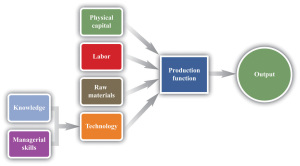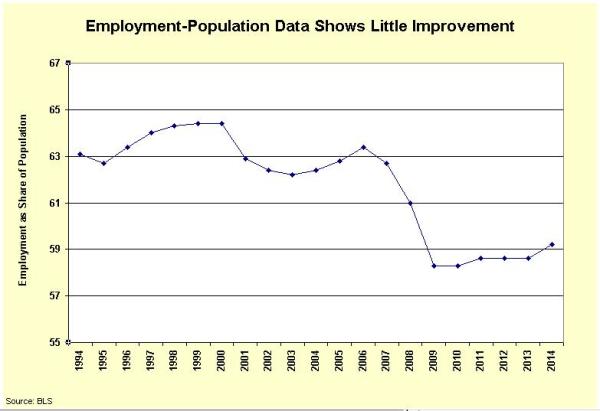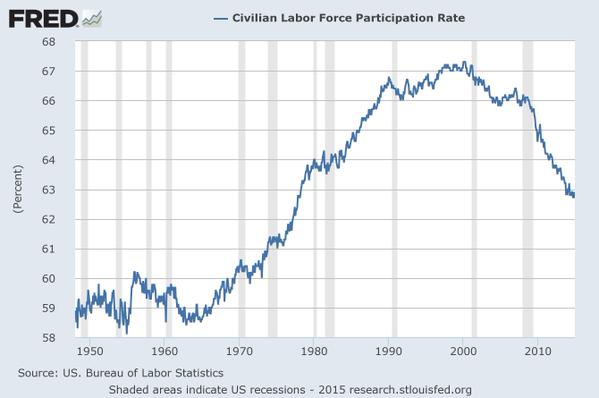For the past several years, on the issue of jobs, I’ve focused more on the employment-population ratio rather than the official unemployment rate.
Both figures are important, of course, but I think the employment-population ratio has more economic meaning since our prosperity ultimately is based on how many people are productively employed.
 To put this in wonkish terms, our national economic output is a function of the efficient allocation of labor and capital.
To put this in wonkish terms, our national economic output is a function of the efficient allocation of labor and capital.
The reason I bring this up is that many people think the job market is now in great shape because the unemployment rate has dropped to 5.6 percent.
To be sure, that’s good news when compared to the much higher rates of joblessness that plagued the nation a few years ago. But one of the reasons the unemployment rate has dropped is that many people have left the labor force.
Here’s a chart based on data from the Bureau of Labor Statistics showing how many people have jobs compared to the working-age population. As you can see, there’s been scant improvement in this important indicator.

The problem isn’t that the ratio plummeted during the downturn. That always happens.
What’s worrisome is the fact that there wasn’t a bounce back in the right direction after the economy started to improve.
Indeed, it’s become such a problem that the establishment media has started to notice.
Here’s some of what Reuters reported on Fridays good news/bad news jobs report.
…wages posted their biggest decline in at least eight years in a sign the tightening labor market has yet to give much of a boost to workers. …The jobless rate fell 0.2 percentage point to a 6-1/2-year low of 5.6 percent, but that was mainly because people left the labor force. The drop in labor participation and a surprise five-cent, or 0.2 percent, decrease in average hourly earnings…the labor force participation rate, the percentage of the working age population who either have a job or are looking for one, dropped back to the 36-year low of 62.7 percent reached in September.
The labor force participation rate, which is mentioned in the Reuters article, is another set of data that is rather similar to the employment-population rate.
Here’s a chart that’s been circulating on Twitter, based on data from the St. Louis Federal Reserve. You can see that the labor force participation rate jumped significantly between 1970 and 1990, in large part because more women were entering the job market. But in recent years, the trend has been in the wrong direction.

And if you parse the data, you can see that the big problem is among those without a college degree.

Now that we’ve cited lots of data, let’s speculate on why we have fewer and fewer people productively employed.
There are several possible answers, including the big increase in peoplescamming the disability system.
There’s also the jump in tax and regulatory burdens, though that presumably impacts all economic statistics.
Obamacare deserves its own special mention since it imposes a significant penalty on work.
And, until recently, the government had a policy of endless unemployment benefits that made work relatively less attractive.
So the bottom line, as you might expect, is that the problem is too much intervention and bloated government. Which means the answer is free market and less government.

